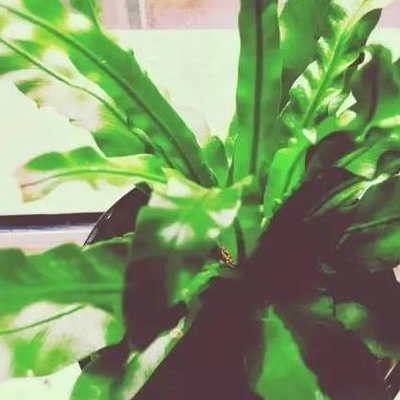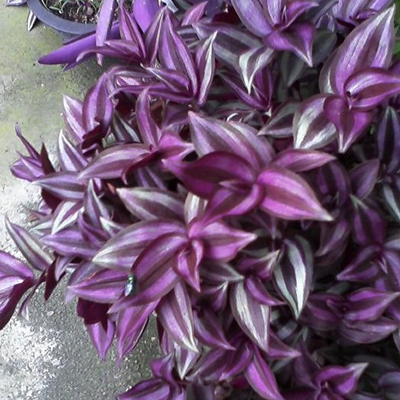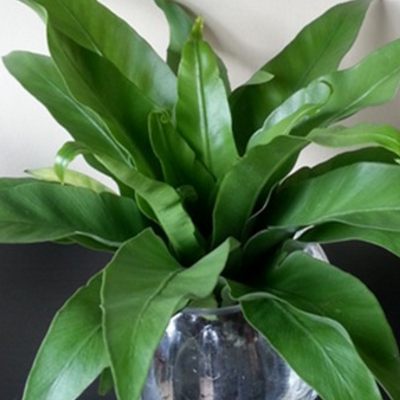Can the breeding method of bird's nest fern be put in the bedroom?
Bird's nest fern, this kind of plant is still a little interesting, can actually be hooked with the bird's nest, what is the breeding method of bird's nest fern? Can bird's nest ferns be raised indoors:

The culture method of bird's nest fern:
1. Pot maintenance
It is very suitable for pot conservation of green plants, choose a good ventilation and drainage flowerpot, the soil can directly use peat soil or rotten leaf soil, the appropriate addition is some river sand, the soil covered with some mature organic fertilizer, so as to ensure adequate nutrients, but also to make the maintenance medium permeable and loose, drainage also has a better guarantee.
2. Light and temperature
Bird's nest fern is a kind of plant that likes a cool environment. In summer, we must avoid exposure to the sun, do not let the sun shine directly, and maintain a ventilated and shady environment. Only in this way can its leaves remain green.
Maintain a warm environment during maintenance, the temperature between 20 and 30 degrees is its peak growing season, the lowest temperature should be higher than 5 degrees, so that frostbite can be avoided, and the summer temperature is more than 35 degrees. Spray water around to cool down early, colleagues should keep good ventilation, muggy water can easily cause plants or leaves to rot.
3. Moisture and fertilizer
Watering is to pay attention to the basin soil slightly dry when replenishing water, to avoid the soil is too dry, the second is to ensure environmental humidity, to avoid dry air.
Bird's nest fern does not have a great demand for fertilizer. During the maintenance period, we can ensure that there is a thin liquid fertilizer once or twice a month during the maintenance period, so that we can maintain a good growth condition.
Note:
Ye Xin should try not to accumulate water for a long time, especially in the hot and muggy environment in summer, otherwise it is easy to rot. If leaf spots appear, you should spray topiramate or chlorothalonil in time to prevent diseased leaves from rotting.
Can bird's nest ferns be raised indoors:
Bird's nest ferns can be raised indoors and are said to release oxygen 24 hours a day.
This is the end of the introduction to the breeding method of bird's nest fern. Come and raise one as soon as possible.
Culture methods and precautions of bird's nest fern the function of bird's nest fern
Bird's nest fern leaves are green and green, the leaves are large and long, and they are very ornamental. Many friends like to plant potted plants indoors. How to raise potted bird's nest ferns? What are the functions of bird's nest fern? Let's learn about the breeding methods and precautions of bird nest fern and the function of bird nest fern.
I. the culture method of bird's nest fern
1. Soil: bird's nest ferns like fertile peat and humus soil. Bird's nest ferns grow for more than two to three years, and the plant shape will fill a basin. It is necessary to divide plants in time to change the basin, which is generally carried out in spring. Some rotten leaf soil and moss can be added to the new soil, and a little gravel can be added to improve the soil's air permeability.
two。 Watering: summer is the period of rapid growth of bird's nest fern, at this time should spray more water, improve air humidity, but also conducive to cooling. With the growth of the plant, the leaves will cover the whole flowerpot, watering should pay attention to watering thoroughly, so as not to dry or curl the leaves.
3. Temperature and light: the most suitable growth temperature of bird nest fern is about 22-27 ℃. Bird nest fern is not resistant to high temperature and frost. Necessary shading should be carried out in summer high temperature season. Outdoor culture should choose places with bright and good scattered light. Reasonable temperature light will make the leaves of bird nest fern oil green and shiny.
4. Fertilizer: the special shape and structure of bird's nest fern is beneficial to its absorption of water and nutrients. Its rhizome is short and densely scaly, and produces a large mass of spongy fibrous roots, which can absorb more water. Potted bird's nest fern, in its vigorous growing season, should be irrigated with a balanced thin fertilizer of nitrogen, phosphorus and potassium every semimonthly, which can promote it to grow a large number of new leaves. If the plant is short of fertilizer, the leaf edge will turn brown. If the summer temperature is higher than 32 ℃ and the greenhouse temperature is lower than 15 ℃ in winter, all forms of topdressing should be stopped.
2. Matters needing attention in bird nest fern culture
When the bird's nest fern grows larger, there will be small branches. At the end of spring, the root can be separated with a knife. When transplanting, the potted soil should not be too wet, otherwise the root will rot. The newly transplanted bird's nest fern leaves can be cut off to facilitate survival. With the growth of bird's nest ferns, the leaves will gradually return to their original appearance. Bird's nest fern leaves are delicate to prevent exposure and frost, but can not be irradiated without light for a long time, and can be placed in a place with good scattered light conditions.
The function of bird's nest fern
1. Ornamental value: bird's nest fern is a large shady foliage plant with plump plant type, green and bright leaves, chic and generous, rich game, which is favored by people. Hanging indoors also has a tropical flavor; planted under tropical garden trees or rockery rocks, it can add wild interest; small potted plants are used to decorate bright living rooms, conference rooms, studies and bedrooms, which also appear small and exquisite, dignified and beautiful.
2. Medicinal value: bird's nest fern is rich in vitamin A, potassium, iron, calcium, dietary fiber and so on. The fern in the bird's nest tastes bitter and warm, entering the kidney and liver. It has the effect of strengthening muscles and bones, promoting blood circulation and removing blood stasis, and can also be used for injury, fracture, blood stasis, headache, hemolysis, impotence and gonorrhea.
3. Edible value: the edible part of bird's nest fern is its tender bud. After picking, rinse the bird's nest fern with clean water, then blanch it slightly in boiling water, remove it and drain it, add various seasonings for cold dressing, or stir-fry with other ingredients.
4. Purify the air: bird's nest ferns can absorb formaldehyde, and ferns such as bird's nest ferns can purify the air indoors. In general, Cymbidium is a plant commonly used by citizens to absorb formaldehyde, and the effect of ferns absorbing formaldehyde is obviously better than it. Under the specific experimental environment, the ability of absorbing formaldehyde was as follows: Jinglan grass > kidney fern > bird's nest fern > Dryopteris przewalskii > Dryopteris bicolor.
The above are the breeding methods and precautions of bird's nest fern and the function of bird's nest fern. Friends who don't know the breeding method and function of bird's nest fern can take a look and put them away.
The culture method of bird's nest fern (with the function of bird's nest fern)
Bird's nest fern (Latin name: Asplenium nidus), also known as Suhua, is a species of fern belonging to the family Pteridaceae, belonging to perennial shady herbaceous foliage plants. So, what are the breeding methods of bird's nest fern? Let's take a look.
I. the culture method of bird's nest fern
When the temperature is high, it can be watered frequently, every day or every other day, and under low temperature conditions, it can be carried out once every 3-5 days, so it must be flexible! The temperature between 15 and 26 ℃ can irrigate thin fertilizer and water, which is very beneficial to growth and growth.
Note: bird's nest fern likes warm and humid environment and is not resistant to high temperature and cold. Spray more water and ventilation when it is higher than 30 ℃. Like high wet environment, can not bear to dry! Please spray water frequently to increase air humidity! In addition, although the bird's nest fern is more shade-tolerant, it also needs scattered light to grow better! Don't leave it in a place without light for a long time! Of course, avoid exposure to the sun when the sun is strong!
1. Peat soil or rotten leaf soil is the best soil for planting potted bird nest fern. The growth depends on planting nest fern for 2-3 years, the plant shape is open, and the root is full of pot rack, which can be protruded from the basin, and some residual roots and spore leaves withered at the base can be removed, taken out in the plant and replanted in the pot respectively. When changing the basin in spring, rotten leaf soil and moss should be added to the basin, and a little gravel should be added.
two。 Temperature and light the suitable temperature for the growth of bird's nest fern is 22-27 ℃. In summer, it should be shaded or placed in a sparse place under a big tree to avoid strong direct sunlight, which is beneficial to growth and make the leaves glossy. Put it in a brightly lit place indoors, not in the dark for a long time. It should be moved into the greenhouse in winter and the temperature should be kept above 16 ℃ so that it can continue to grow, but the lowest temperature should not be lower than 5 ℃.
3. Watering and fertilization under the conditions of high temperature and humidity in summer, the vigorous growth of new leaves need more water, fully spray the leaf surface and maintain a higher air temperature, which is beneficial to spore germination. With the increase of the leaves, the leaves are often covered with the culture soil in the basin, and the pot must be watered thoroughly in order to avoid the dry and curl of the leaves caused by the lack of water.
Bird's nest fern can be sown and propagated by spores. Spore propagation has been widely used as a commercial batch production. Generally available ramet propagation. When the plant grows larger, there will often be small branches, which can be cut off slowly with a sharp knife before the new buds are born in late spring and early summer, and then planted separately. Bird's nest fern produces fewer branches and uses less common ion plants. Usually, the robust plant is cut into 2-4 pieces from the base at the end of spring, and the leaves are cut short by 3-1 stroke 2, so that each piece has part of the leaves and rhizome, and then potted into a new plant; after pot planting, the plant is maintained in a semi-shady place with a temperature above 20 and high air humidity, so that the wound can heal as soon as possible. The cultivation substrate in the basin is slightly moist, not too wet, otherwise it is easy to rot. After the new leaves are born, they can gradually return to their original shape.
Second, the leaves of the bird's nest fern turn yellow
There are many reasons for the yellowing of bird's nest fern leaves, the main reason is improper maintenance. Only by prescribing the right medicine to the case and careful maintenance can the yellowing of bird's nest fern leaves be completely solved.
Causes of yellowing of bird's nest fern leaves
Bird's nest ferns are often attached to tree trunks or rocks in rainforests or seasonal rain forests. They are not tolerant to strong light and belong to shade plants. If the light is too strong, the leaves of bird's nest ferns will turn yellow. It may also cause the yellowing of bird's nest fern leaves due to improper growth environment and improper maintenance. Especially in the north, where the air is dry and the light is strong, bird's nest ferns will dry up at the edge of the leaves and dry and crack the leaves.
The solution to the yellowing of bird's nest fern leaves
If you know the reason, you can know how to prevent the leaves of the bird's nest fern from yellowing. First of all, we should try to ensure that the environment is shady and humid, and can be maintained in a shady place, not in bright places such as balconies and windowsills, especially in summer to absolutely avoid direct sunlight and often spray water to ensure humidity. Like Yin does not mean unlimited watering, to ensure that the breeding bird's nest fern substrate is wet! We should also understand the growth habits of bird's nest ferns, understand the habits of bird's nest ferns, and adjust the habit of growing flowers according to the habits to avoid the yellowing of bird's nest fern leaves.
Third, the function of bird's nest fern
1. The ornamental value of the function of bird's nest fern
Pteridophytes are very popular among foliage plants in recent years. It is popular in the world to make large-scale hanging or wall-hanging potted plants for hanging decoration in spacious halls, or to attach single clumps of bird's nest ferns to different height parts of a section of tree trunks to form a sturdy appearance of ancient trees. placed in the hall or corridor like a line of ancient trees. Decorated with bird's nest ferns, the interior has a unique tropical scenery, but also can add some vivid natural wild interest. It gives people great visual enjoyment and has a strong ornamental value.
2. The function of bird's nest fern to decorate the home
Bird's nest fern is a large shady foliage plant with plump plant type, green and bright leaves, chic and generous, rich game, which is favored by people. Hanging indoors also has a special tropical flavor, planted under tropical garden trees or rockery rocks, can add wild interest, potted small plants are used to decorate bright living rooms, conference rooms and studies, bedrooms, but also appear small and exquisite, dignified and beautiful.
3. The function of bird's nest fern to purify the air
It is said that the bird's nest fern in the house may release more oxygen than other plants and cannot smoke, but it can absorb harmful gases such as nicotine in the smoke and purify the air to a certain extent.
4. The market value of the function of bird's nest fern
Bird's nest fern leaves are green and bright, green and bright, natural and generous, rich in game, is commonly used in flower arrangement, and the leaves of bird's nest ferns are also excellent flowers.
5. the edible and medicinal value of the function of bird's nest fern.
The role of bird's nest fern is mainly reflected in the use and potted plants. Bird's nest fern can be used as a potted and planted plant, and its leaves are excellent flowers, but bird's nest fern also has edible and medicinal value. The curly tender leaves of bird's nest fern can be fried, cooked or made into kimchi. The nature of bird's nest fern is slightly bitter and can be used for heat-clearing and detoxification.
The above is the breeding method of bird's nest fern introduced to you by Xiaobian. I hope it can help you. For more information about bird's nest fern, please stay tuned.
- Prev

How to raise Prunus mume by Cuttage Propagation
Hanging bamboo plum, this kind of plant is super good-looking, it is green all the year round, how does hanging bamboo plum raise explosive pot? What is the method of cuttage propagation of hanging bamboo plum: how to raise the popping pot: hanging bamboo plum is originally a kind of plant that lives on wetlands, so we know that it likes wetting very much.
- Next

Can bird's nest fern be hydroponically cultured? what about the scorched edges of the leaves?
Bird's nest fern, as many people know, can be raised at home. Let's see if bird's nest fern can be hydroponically cultivated. What to do about the burnt edge of the bird's nest fern leaf: can the bird's nest fern be hydroponically cultivated? the method is as follows: temperature, the suitable temperature for the growth of bird's nest fern is 16 ℃-27 ℃, and the temperature drops below 10 ℃.
Related
- Fuxing push coffee new agricultural production and marketing class: lack of small-scale processing plants
- Jujube rice field leisure farm deep ploughing Yilan for five years to create a space for organic food and play
- Nongyu Farm-A trial of organic papaya for brave women with advanced technology
- Four points for attention in the prevention and control of diseases and insect pests of edible fungi
- How to add nutrient solution to Edible Fungi
- Is there any good way to control edible fungus mites?
- Open Inoculation Technology of Edible Fungi
- Is there any clever way to use fertilizer for edible fungus in winter?
- What agents are used to kill the pathogens of edible fungi in the mushroom shed?
- Rapid drying of Edible Fungi

